The Early History of the Corset
By Anne Dealy, Director of Education and Public Information
In February I presented our first History Sandwiched In program at the museum. I focused on Victorian undergarments and how they shaped fashionable clothing. The underwear of previous centuries fascinates modern people. The full crowd we got on a Wednesday at noon shows this. In this post, I will look at the early history one of those garments: the corset.
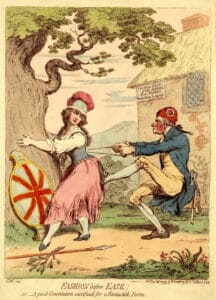
Corsets and other vanities were popular subjects of cartoonists in the 18th and 19th centuries. Fashion Before Ease, James Gillray. Trustees of the British Museum.
Few articles of clothing in western culture are more interesting to modern Americans than the much-maligned corset. Mention of this undergarment often brings to mind images of Scarlett O’Hara being tightly laced into her corset in the movie Gone With The Wind. Like many aspects of this film, the image is a distortion. If you search “corset history” you will find 32 million hits on Google. You will also find many, many inaccurate and distorted accounts of what corsets were, why women wore them, and their effects on the body. Undergarments in general and corsets in particular are not intended to be instruments of torture. They served a purpose; a purpose that sometimes involved discomfort, but no more so than some contemporary garments we choose to wear.
The definitive history of the corset is The Corset: A Cultural History by historian Valerie Steele, Director and Chief Curator of the Museum at the Fashion Institute of Technology. In the first chapter she addresses this view of the corset head on.
In this book, I shall challenge the reductiveness of this picture, which frames the history of the corset in terms of oppression versus liberation, and fashion versus comfort and health. Corsetry was not one monolithic, unchanging experience that all unfortunate women experienced before being liberated by feminism. It was a situated practice that meant different things to different people at different times. Some women did experience the corset as an assault on the body. But the corset also had many positive connotations — of social status, self-discipline, artistry, respectability, beauty, youth, and erotic allure…. Moreover, women wore different kinds of corsets; they laced their corsets more or less tightly and to different ends. In short, their embodied experience of corsetry varied considerably.
- Medieval gowns were loose and flowing robes without structured foundational supports. Rijksmuseum Collection.
- By the early 1500s, a stiff stay shaped the torso into an upright cone, and skirts and jackets became heavier, stiffer, and straighter. Rijiksmuseum Collection.
According to Steele, the early history of the corset begins with the stays1 or bodies. This garment emerged at the end of the medieval period and beginning of the European Renaissance. Clothing for women and men had hung loosely on the body from antiquity. In the middle ages, it began to follow the body more closely. Tunics and loose robes gradually became fitted gowns, doublets, and hose. These garments were tailored through seams, gores, lacing, and padding. They conformed to and exaggerated body parts. Beginning in the early 1500s, women began to wear heavier and wider skirts which required more foundational support. Europeans were exposed to new ideas, materials, and technologies which also influenced fashion
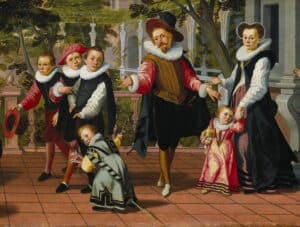
Stiffened and structured garments shaped clothing for men, women and children as seen in this image of a Dutch family from 1599. Rijksmuseum Collection.
Deportment and control over the body became a marker of elite status at this time. Appearance reflected morality. Words like “rectitude”, “upright” and “loose” became associated with moral behavior. Clothing was a way to express wealth and position. Aristocratic parents swaddled their babies and corseted their children to reinforce rigorous posture. Although both men and women wore corsets at times, they became associated with women’s fashion. Over time, corseting spread from the aristocracy down to the working class. The Victorian emphasis on correct posture descended from these sixteenth-century ideas.
Fashionable posture in western culture has changed over time. Corseting has changed with it. From rigid cone-like forms to softer structures, undergarments have made a wide range of fashionable shapes possible from the 1500s to the present.2 Over time, corsets and other garments have variously raised, separated, and compressed the bosom; flattened the stomach; narrowed the waist; and smoothed the hips. From whalebone and steel to Lycra, people have used clothing to reshape the body to reflect the cultural ideals of their time.
In my next post, I will take a look at a corset from the Historical Society collection. We explore what it can tell us about fashionable ideals in Geneva in the 1800s.
Footnotes
[1] These garments were primarily called “stays” until the mid-1800s, when “corset” became the preferred term. For simplicity, I will use the term corset throughout this post.
[2] Today’s fashionable form is supposed to convey health and devotion to physical activity, however, the popularity of contemporary shapewear belies our discarding of the corset.
Sources
For a more complete history of 16th century corsets and an extensive bibliography: http://www.elizabethancostume.net/corsets/history.html
Excerpts from Valerie Steele’s The Corset: A Cultural History can be found here: https://www.chron.com/life/article/The-Corset-A-Cultural-History-by-Valerie-Steele-2030984.php

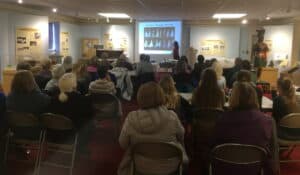

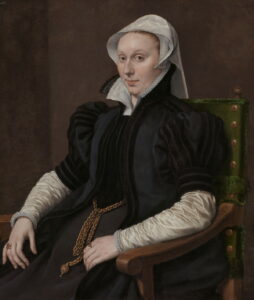
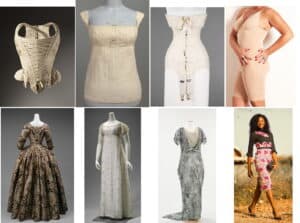
Glad you’re doing this from the History Sandwiched In program. It conflicted with our book group, but we all wanted to be there. Thanks! Looking forward to the next one.